RK Shriramkumar
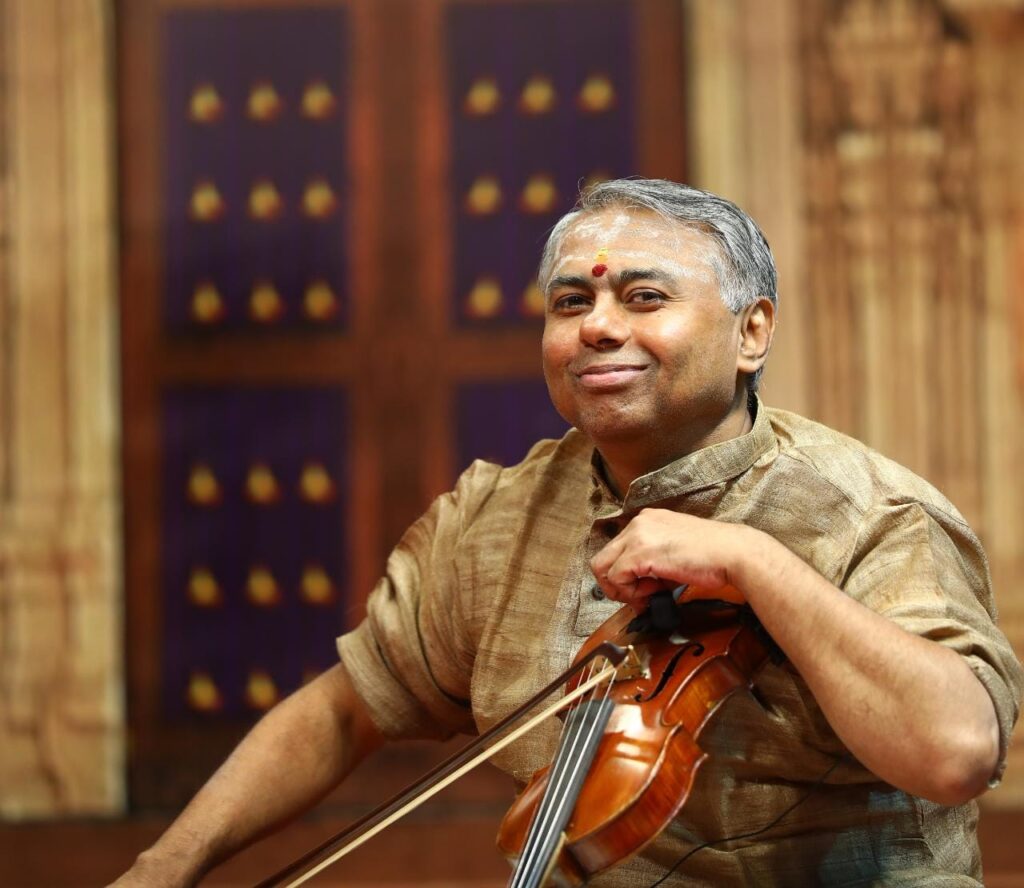
His calm and composed countenance belies the vidvat within. RK Shriramkumar’s is profound all-round musicality, signifying an amalgam of intellect, knowledge, creativity and bhAvam (the conveying of emotion) combined with dedication and deference to the artform itself. He is a solo violinist, accompanying violinist, respected vAgayEkkAra (a lyricist who also sets tune to the compositions), adept tunesmith, incredibly successful vocal and violin Guru, polyglot, and encyclopaedia sought after by the entire musical fraternity.
A version of this article appeared in The Hindu dated October 7th 2022 and is part of the Kalpalata Fellowship for Classical Music Writings for 2022.
A highly desired co-artiste for almost 40 years, Shriramkumar has shared the stage numerous times with doyens like Semmangudi Srinivasa Iyer, MS Subbulakshmi, DK Pattammal, DK Jayaraman, T Brinda, T Mukta, KV Narayanaswamy, M Balamuralikrishna and more, scores of his own contemporaries, those in between, and juniors as well. The latest recipient of Kartik Fine Arts’ Tamizh Isai Vendar title, Shriramkumar, 56, stands out, above all, in how lightly his accomplishments sit on his shoulders. Beloved by follower and dissenter, expert and novice, male and female, performer and organiser, he treats the youngest to the oldest with utmost dignity and respect. It is no wonder that he has one of the most packed schedules of any artiste.

Photo courtesy: Sri. RK Shriramkumar.
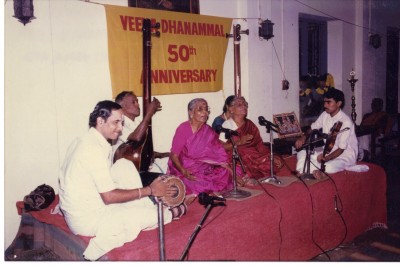
Photo courtesy: rkshriramkumar.org
A lot of exposure to senior stalwarts, early on, resulted in Shriramkumar’s bar for music being set high. “My mind constantly goes to how Amma (MS Subbulakshmi), Pattamma, KVN, or DKJ might sing.” Coming from a lineage of musicians from Rudrapatna in Karnataka, his paternal grandfather, respected violinist RK Venkatarama Shastry, was Shriramkumar’s guiding light for life and music. From the very beginning of training, his very religious and widely-read thatha pulled in references to spiritual texts and day to day contexts, even as he pointed out nuances in the sAhityam (lyric) and rAgam (melodic scale) to his attentive grandson who took it all in and then added on a library of his own. Shriramkumar spent significant time at The Music Academy, tagging along with his grandfather who was on the Experts Committee, getting tremendous exposure to quality music at the formative stage.
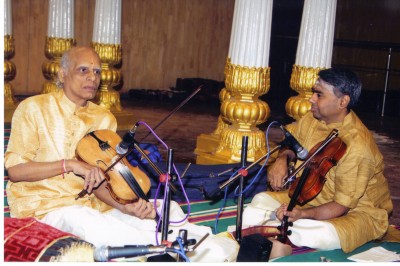
Photo courtesy: rkshriramkumar.org
Shriramkumar’s style of violin playing is underpinned in total faithfulness to vocal, something his thatha, Venkatarama Shastry, and all his other Gurus practiced – DK Jayaraman, Savitri Satyamurthy and VV Subrahmanyam and the several doyens who moulded him like Semmangudi Srinivasa Iyer, MS Subbulakshmi, DK Pattammal, KV Narayanaswamy and TN Krishnan. “They were very particular – from the number of bows reflecting the lyric perfectly, technique used to reflect the gamakam-s (oscillated notes) and emoting according to the composition and the rAgam. VV Subrahmanyam shaped technique while imparting knowledge of deeper realms of the music– profound knowledge from a lifetime of exploration. “Every class was immense discovery.”
Classes with his primary vocal guru, DK Jayaraman, were sheer joy, he says. “I learned so much from him – kriti-s and manodharmam (spontaneous improvisational aspects) – in a very encouraging and friendly environment. He was the first senior musician to take me on for his concerts. That led to other seniors noticing me and calling me too. It was he who recommended me to Pattammal as well.”
Testifying to his absorption from these multiple stalwarts, Lalitha Sivakumar, daughter-in-law of DK Pattammal and her second voice for decades, says, though a violinist, Shriramkumar is a complete musician, an expert in vocal nuances that reflect beautifully in his playing, accentuated by his expertise in Sanskrit and all four southern languages. “I can hear every word of each sangati in his playing,” she says.
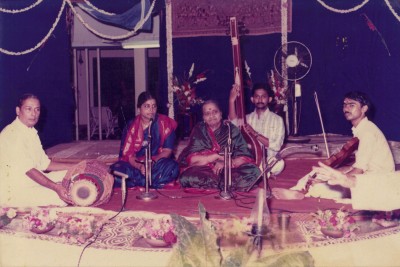
Photo courtesy: rkshriramkumar.org
Vocalist and contemporary, N Vijay Siva says that Shriramkumar is a rare violinist in whose playing every word can be discerned clearly even in druta kAla (fast speed) neraval (improvisation of a line or phrase of a composition). (Shriramkumar’s first ever concert was accompanying Vijay in 1981).
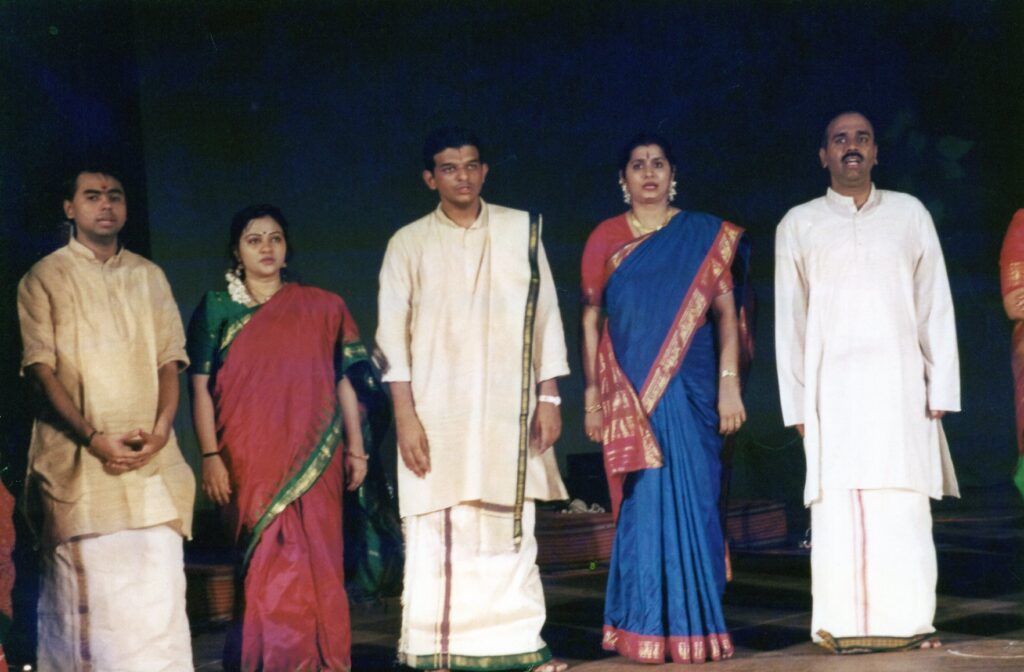
Photo courtesy: Sri. N Vijay Siva
Besides lay rasika-s, Shriramkumar’s solo violin performances are attended by numerous performers, not for technical perfection or skill in the instrument, but for the distilled essence of multiple exalted pATAntaram-s, carefully analysed and stringently decanted for quality from a lifetime of listening and first-hand observation.
His renditions will never so much as stray into a grey area of the rAgam, making noticing what he does not play as important as what he does. Vijay states, “He has developed the dexterity of encompassing a kriti and the entire concert with his powerful bowing and accomplishes complete oneness with the musical/lyrical content. He knows when to bow and when not to bow, not only for a kriti but the entire concert. The next generation cannot afford to bypass the opportunity of absorbing this attribute.”
As an accompanying violinist, Shriramkumar is easily one of the most sought-after. MS Subbulakshmi’s husband, T. Sadasivam, was most struck by how identically Shriramkumar would follow in his playing. He was a frequent subject of conversation among the senior-most doyens for his quality playing.
That to-date, even the most senior musicians decide their dates of performance to fit his open slots further speaks for itself. Whether PADi or KalyANi, expected prayogam-s or sudden googlies, he will respond with unfazed poise. Though an expert and a scholar himself, while accompanying, he is squarely and totally an accompanist, striving to showcase his co-artistes in the best light, masking any difficulties they might be facing, thus raising the level of the concert itself. Mirroring his co-artistes, he keeps his own solo responses intentionally brief but musically wholesome and satisfying, giving others more time to perform. Sangita Kalanidhi-designate, mridangist Thiruvarur Bhaktavatsalam says, “He knows how to play for each artiste and, above all, ensures that he is completely non-intrusive.”
Senior vocalist Rama Ravi refers to his playing most supportively for her, allowing her performance to bloom. She mentions his extensive repertoire and his keen interest to constantly learn.
Mridangist N Manoj Siva says, “Violinists and percussionists, as pakkavAdyam artistes, play a supporting role. Shriramkumar is one who has truly understood ‘pakkavAdya dharma’ (accompanying etiquette).”
Mridangist K Arun Prakash says an entire lecdem can be devoted to how Shriramkumar accompanies. Manoj adds, “Be it on stage or off, Shriramkumar’s very presence provides comfort – making him a favourite for any concert team.”
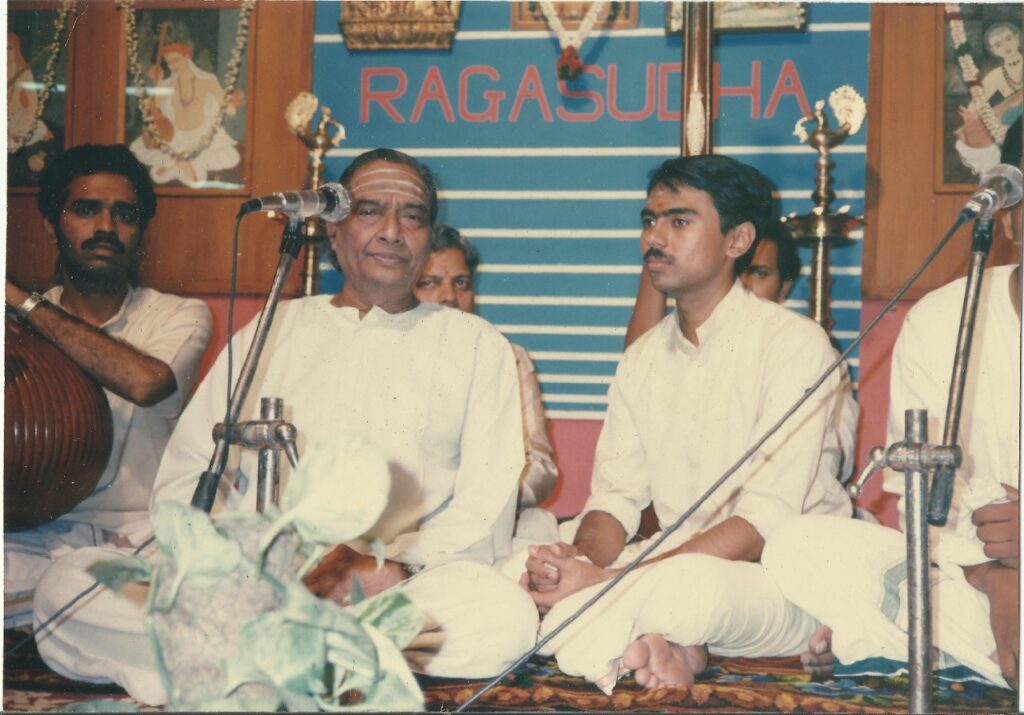
Photo courtesy: rkshriramkumar.org
Students accompany Gurus at concerts as a matter of routine, but Shriramkumar might well be the only teacher to regularly accompany his vocal students on the violin at concerts. “They sing dignified and proper music, respecting the composers and the stalwarts. They invite me affectionately and it is my pleasure to play alongside them.” The art of accompanying necessitates adjusting one’s musicianship for others, reining oneself in, playing second fiddle. That he does so sans ego for his students and much younger artistes, exactly as he would for senior stalwarts, is admirable indeed. Referring to his accompaniment, one of his earliest and long-time students, Amritha Murali, says, “His presence inspires and boosts confidence, but never intimidates. Most admirable is that he will never overpower or do something we have not just because he knows to, or he can.”
Several violinists and percussionists will not perform with women (or those who play with women) and many who do, stop playing eventually. Shriramkumar, however, has always steadfastly done so, particularly creditable since those who accompany ladies are constantly advised not to, to avoid careers stalemating. “It is very sad that people have such views – many meritorious women do not get the recognition they deserve as a result.” Indeed, female musicians do not get the early leg up that their male compatriots do when reputed male-exclusive senior violinists and percussionists accompany them early in their career – the perceived competency and the fan base of the other artistes adding weight at a crucial time. “Only quality of music should matter,” says Shriramkumar. Women have been critical forces throughout his life. He mentions his mother, Mrs YGP and several teachers at his school (PSBB), MS Subbulakshmi, DK Pattammal and many more. One should note that his grandfather too played for several female musicians in his career.
Prolific musicians are always highly appealing Guru-s, but few teachers can claim to have produced as many active performers (many very popular) as Shriramkumar has – a testimony to his pedagogy and charisma. Amritha Murali, Ramakrishnan Murthy, Bharathi Ramasubban, Aishwarya Vidhya Raghunath, Madan Mohan, Sandeep Ramachandran and Nanditha Kannan are but a sampling of his numerous students who range from ages 5-80. Vocalist and author TM Krishna says Shriramkumar’s imbibing of the various ways his many Gurus shared knowledge is reflected in how he teaches. “His teaching is very grounded in discipline, rigour, perfection and the ability to understand exactly what you are doing.”
Amritha says, “He leads by example – the music that he passes on is a blend of the best he has imbibed and internalised from several greats and his own musicality and creativity. The way he imparts it is a true delight to experience and watch. No discrimination, no withholding of any knowledge, no time constraints and totally unconditional.”
She continues, “His only expectation is for his disciple to sing well and be true to the art form. He also gives his students ample space to explore, work on their own and create a comfortable space for themselves.” Shriramkumar believes in starting young children on small songs and introducing the traditional basic lessons a little further on, once interest has developed.
Shriramkumar narrates an incident from his own learning days, “KVN mama was teaching me a song in tODi – in a very slow kAlapramANam (speed of rendering). When I played it, it was at a faster speed. He immediately asked why I was rushing. He expected the violin to reflect exactly what was sung.”
“It was the same with MS Amma too. The slightest deviation would be conveyed with the eyes during the performance and verbally later. The rAgam had to be in proportion and the sruti in absolute alignment. I carry this baggage with me which I convey to my students too,” he says, wryly. “I am nit-picky and will point out the subtle differences.” His expectations vary based on the maturity of the student. “With young children, I only expect that they sing a piece properly and correctly. I will tell them the meaning and where one should sing ‘vallinam’ and ‘mellinam’ but it will take time for it all to sink in. However, with older and more experienced students, I do expect them to emote.”
Notably, unlike many teachers who insist on exclusivity, many of Shriramkumar’s students have learned concurrently from others. He sees nothing unusual here, stating that he himself did so. He is accepting of all pATAntaram-s (musical schools), as long as they are faithful to chaste Carnatic music. As a constant performer now for almost four decades, he can draw parallels between multiple generations and styles of musicians, delineating them clearly. For his students who venerate him, his classes provide a safe haven, not only for music but also for unburdening themselves of worldly cares. This combination of knowledge, largesse, lack of insecurity, attentiveness to musical minutiae, and repeatedly proven success, has made Shriramkumar probably the most desired Carnatic teacher of present times.
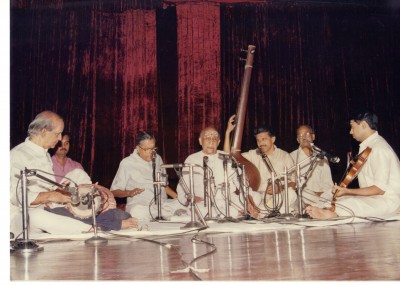
Photo courtesy: rkshriramkumar.org
Shriramkumar is a devout disciple of the Acharyas of the Sringeri Sharada Peetam and Bhaskara Prakasha Ashrama. From celebrating all the festivals with eye catching floral decorations that Shriramkumar does with his wife Akhila, ex-Director at Sankara Nethralaya, to receiving guests and visitors, their home constantly buzzes with joyous activity. He is simultaneously cognisant of current trends but judiciously chooses what to adopt. Not a great fan of social media, he feels, “As much as it brings the world together, and can be really worthy when used sensibly and sensitively, it fosters anxiety and one-upmanship through constant comparison.”
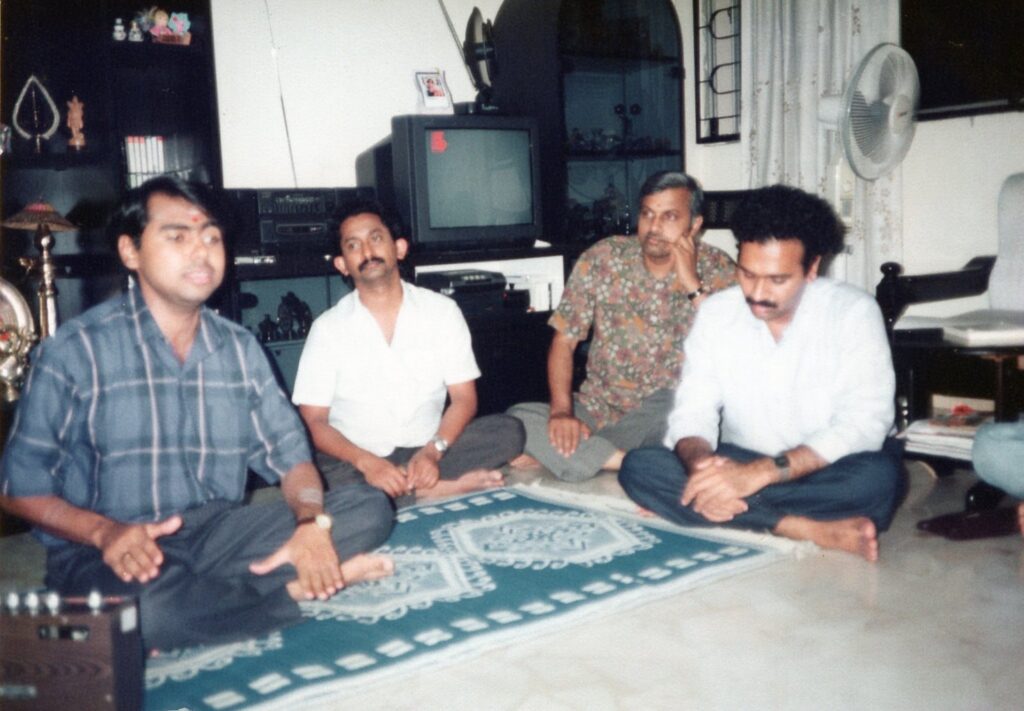
Photo courtesy: Sri. N Vijay Siva.
An astute composer, Shriramkumar’s pieces and pallavi-s are performed by his contemporaries as well as his students and are also popular on the dance circuit. Vijay, Arun, Manoj and Krishna all refer to the stellar quality of his compositions, with sAhityam and rAgam melding to perfection. Manoj was particularly touched by the unison of sAhityam and rAgam in a composition on Shirdi Sai Baba – pAhi sarvada – in Sindhu Bhairavi. Shriramkumar is an exemplary tunesmith too, having tuned several compositions in numerous languages including Bengali and Marathi. Sharada Bhujangam on his beloved Sharadambal, (SArade KaruNAnidhe, in Hamir Kalyani, is particularly popular, and received rave reviews from DK Pattammal, TK Govinda Rao and many more) and Tamil hymns of Thayumanavar are just a few.
He learned a lot from seeing his grandfather, DK Jayaraman, Kadayanallur Venkataraman, RK Srikantan, TK Govinda Rao, Nedunuri Krishnamurthy, Rudrapatnam Brothers and others in the process. “One should be familiar with the language – the stressed and unstressed syllables and placement of the stress within the piece have to be looked at carefully. The word-by-word meaning is important. Also, one should put oneself in the situation depicted by the lyric.” He refers to the scene of Kunti claiming Karna as he lies dying. “An aTANa or a Bilahari might not be the most suitable there. Similarly, setting a lullaby to a lilting rAgam like nIlAmbari or yadhukulakAmbhOji might be more appropriate than a rasikapriya. One should not do things differently just to be different – the context must be in mind throughout,” he insists. He has tuned, and also composed, for television and dance productions, including for Podhigai Channel, the Cleveland Aradhana, Kalakshetra and for Vyjayantimala Bali as well.
He is a sought-after presenter of musical lecture demonstrations and workshops. Laypeople and experts alike will glean something hitherto unknown from his presentations. Krishna says, “Very simply put, he is a scholar who is always interested in learning more. Even if it is the same topic he is presenting, he will strive to find new information each time. Above all, he is not afraid to say he does not know something which, to me, is the greatest sign of a scholar.” To ensure that what he says reaches the audience, Shriramkumar often presents them in concert format with students, illustrating esoteric aspects in a readily digestible manner. Krishna adds, rightly, that unlike many others who spend much time on anecdotes referencing themselves, Shriramkumar focuses entirely on the subject matter. Recently, he took a group on a 4-day musical workshop to Madurai as part of ‘Sunaada Yatra’ organised by Sunaadalahari.
So, how did he acquire the in-depth knowledge needed for these presentations? Shriramkumar says it had its roots in his grandfather who was inherently very spiritual and attended vEdAnta and pravachanam sessions. His explanations with deep and nuanced meaning sparked Shriramkumar’s own innate interest making him pursue his own personal enquiry through books and consultations with experts. He used his working knowledge of all South Indian languages to read composers’ works in their original tongues such as the Sangita Sampradaya Pradarshini in Telugu itself. “The Trinity was ultimate in our home for my grandfather – Thyagaraja in particular. Thatha did the ArAdhanai for Thyagarajaswami in Thiruvaiyaru for over 50 years.” (Since Venkatarama Shastry’s demise on April 15th 1993, Shriramkumar has been performing it annually – note that ArAdhanai here refers to the annual rituals performed for death anniversaries.)
Arun Prakash says, “He epitomises Carnatic values, Carnatic art and Carnatic sound.” If Shriramkumar is held in especially high esteem by the entire fraternity, it is because he is a very courteous, pleasant and approachable person, who will put himself out for others. Though a posterchild for tradition, Shriramkumar listens to everyone, including those with completely contrarian viewpoints, seriously considering their arguments with an open mind. Manoj Siva encapsulates it. “As a human being, he is ideal. Musically, he reflects purity to the Carnatic idiom, portraying impeccable taste which comes out in all aspects – kriti, manodharmam, tuning, composing, accompanying. He is the complete musician.”

Besides Sri. RK Shriramkumar who humoured numerous questions cheerfully, I am thankful to the many artistes who took the time to promptly share their thoughts for this article, including Smt. Rama Ravi, Smt. Lalitha Sivakumar, Thiruvarur Sri. Bhaktavatsalam, Sri. N Vijay Siva (who also painstakingly pulled out several photos specifically for this piece), Sri. K Arun Prakash, Sri. N Manoj Siva, Sri. TM Krishna and Ms. Amritha Murali. I am grateful, as always, to the photographers, those credited below the photos in this piece, and others whose work appears in other articles. They willingly share their magic with the camera, contributing critical visual appeal to the write-ups. rkshriramkumar.org, a website created by Ms. Priyanka Dinakar, was a valuable resource.
Related Links:
RK Shriramkumar – Quarantunes Podcast
Amritha Murali – Quarantunes Podcast
Aishwarya Vidhya Raghunath – Quarantunes Podcast
Thank you for this compilation, Lakshmi Anand. Very much needed.. to have all this in one place!!
Thank you so much for reading.
Listening to R.K.Shriramkumar , following his music, occasionally interacting with him, noticing his multifaceted talent , I am indebted to the Author for chronicling this article on him. This recognition is truly and terribly overdue . He is the most consummate musician that we have in our midst today. His greatness needs to be acknowledged by all institutions by conferring appropriate titles upon him . This way , these institutions will at best honour themselves. I hope that music Academy will lead the others and honour itself by awarding him the 2023 Sangeetha Kalanidhi title.
Thank you for writing in. Much appreciated.